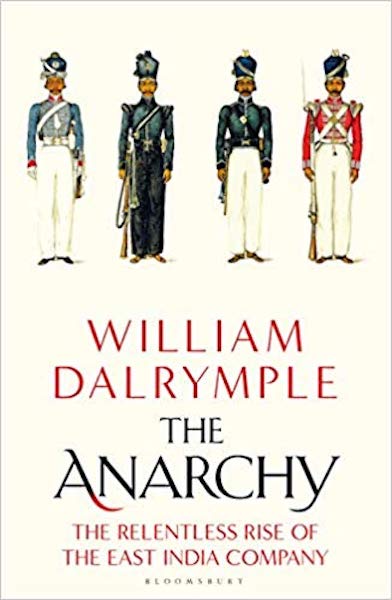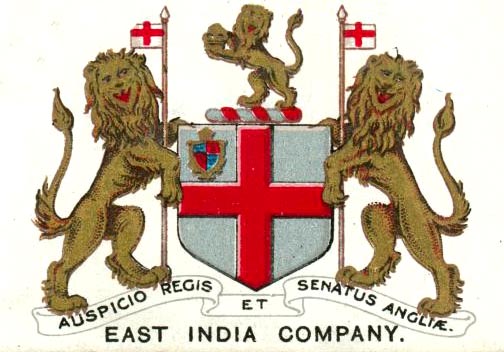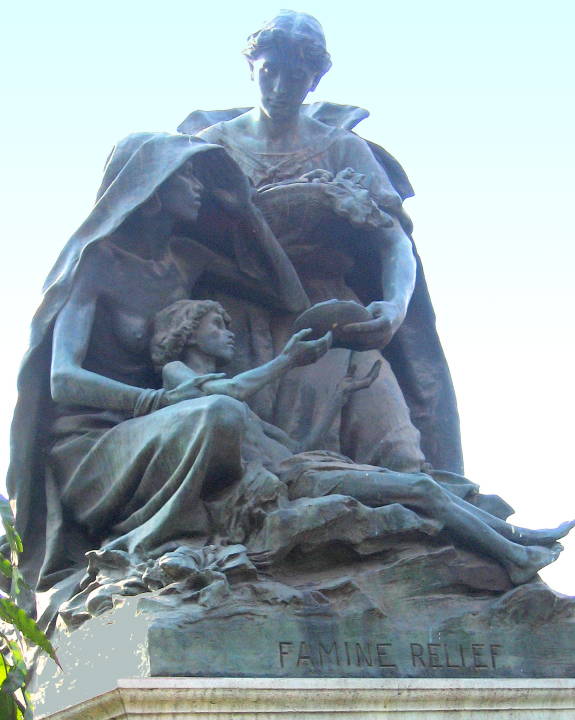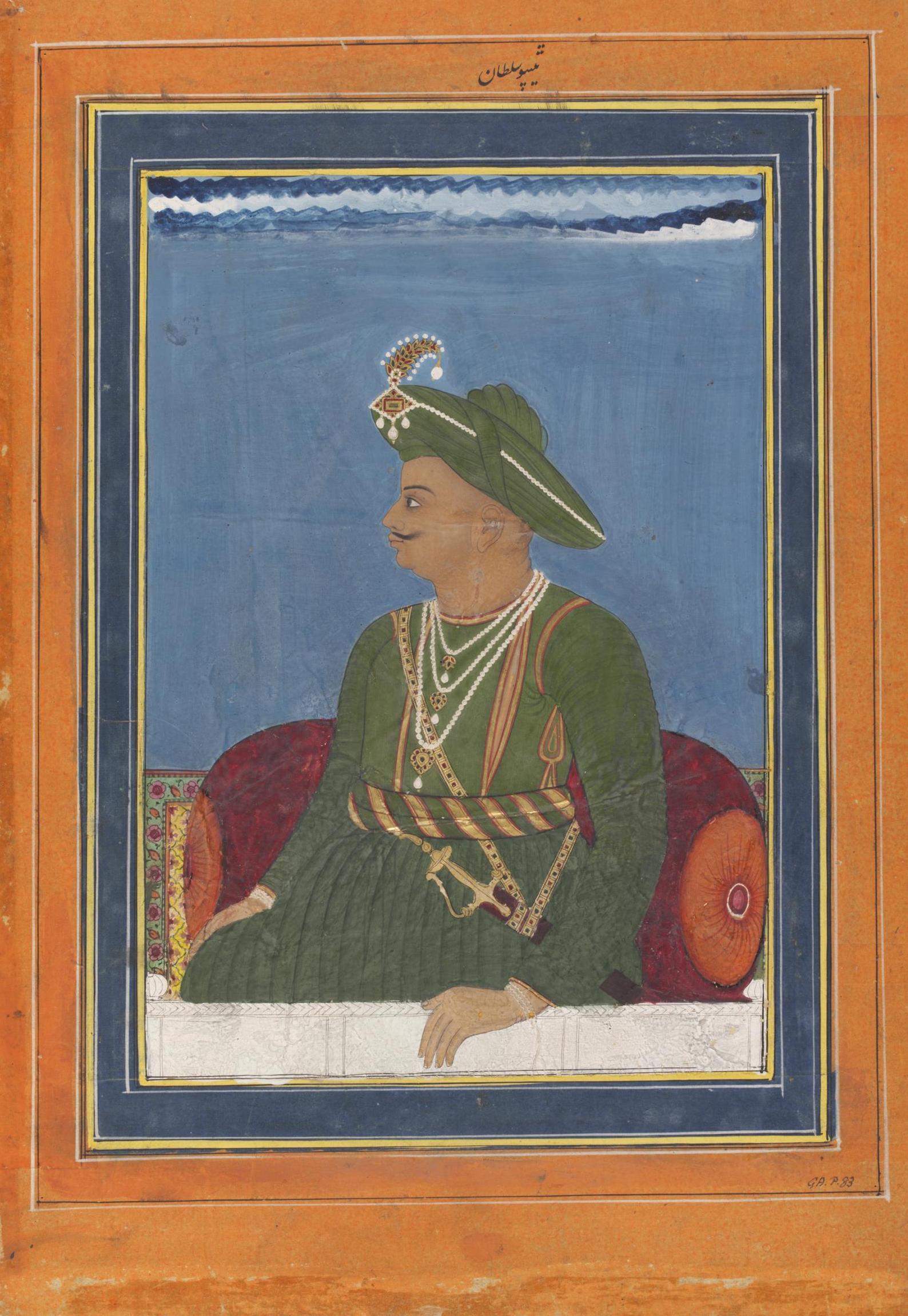It has been considered politic to write of things in India as England would like them to be; but now that our Indian fellow-subjects are greater students of modern Indian history than Englishmen take the trouble to be, it is wiser to state facts than to spread fancies. — Margaret Harkness (1854-1923), on the English conquest of India

William Dalrymple's latest book is a detailed history of the British East India Company (EIC), seen, as it must be seen now, from a post-colonialist standpoint. It opens dramatically with a glimpse inside Powis Castle, seat of Edward Clive, son of Robert Clive of India, himself an administrator in India and first earl of Powis (1754–1839). The English had originally awarded the estate in medieval times to the last hereditary Welsh prince, when he relinquished his entitlement — an ominous enough note on which to start. More telling still, the castle is now “simply awash with loot from India, room after room of imperial plunder, extracted by the East India Company” (xxii). This was all acquired by the Clives several centuries later, and exemplifies the extraordinary riches that the Company was raking in then. Such spoils allowed it to lobby MPs and shareholders to support its activities in India in the seventeenth and eighteenth centuries. What follows is the full story of how a private commercial company was able to establish the roots of colonialism in India, an essential background to any clear understanding of the Indian "Mutiny" or First War of Indian Independence in 1857.
In outline, the story is well enough known. The devil, however, is in the detail, and there is a great deal of it here, none of it showing the British in a good light. As Dalrymple explains, they had been sending ships to foreign lands, mainly for commercial purposes, since at least Elizabethan times. Tudor merchants would pool their resources to form joint stock companies, attracting passive investors, who themselves did not conduct the business, but helped to fund it and shared the profits — and sometimes the losses. This was the situation when, on the last day of 1600, the Governor and Company of Merchants of London trading to the East Indies “received their royal charter” (9) from the Mughal King Jehangir. Dalrymple traces the establishment and development of the East India company from this first momentous step onwards, weaving his account from the life and deeds of the British who went out to India to explore, build on (that is, exploit) and defend their access to the commercial prospects there.
Early Years

The arms of the East India Company. Click on this and the following images to enlarge them, and usually for more information about them.
The first commander of an EIC trading ship to set foot in India was Captain William Hawkins, who put into harbour at Surat on 28 August 1608. This early foray was not very promising: from the powerful Jehangir, Hawkins gained little except an impression of his power — "the Mughal kept a staggering four million men under arms" (15) — and the gift of an Armenian Christian wife (Miriam Khan; see note). Deciding that a more impressive emissary was required, the company next dispatched the MP and diplomat Sir Thomas Roe. On arrival, Roe discovered that “the Mughals regarded [the British] relations with India as a very low priority” (18). Returning to London, he confirmed to the directors of the EIC that arms were not an option: trade, however, did seem possible. Initially, the Company tried to negotiate commercial privileges and they largely succeeded in doing so. They traded in jewels, pepper and textiles, and soon outdid the existing Dutch merchants in trade. The EIC began to reap enormous profits from their new venture.
This was just the beginning. While the Mughals were still powerful, they discouraged any political moves, so that when the Company tried its strength against them it was firmly rebutted. The Nawab of Bengal disliked the British and wrote to his maternal nephew, soon to become the fearsome Mughal Emperor Aurangzeb, that the “English were a race of 'quarreling people and foul dealers'” (24). Once into the seventeenth century century, the reckless Sir Josiah Child, who had become the director of the Company, displayed his ambitions when he said that British men must either desert their trading interests or “draw the sword his majesty has Intrusted us with, to vindicate the Rights and Honour of the English Nation in India” (24). The British duly sent a large army with cannons, but they were routed by the powerful Mughals. An observer remarked scornfully that the British soldiers “live like Englishmen, and die like rotten sheep” (25). However, the British had not given up, and eventually their chance came. The death of the last great Mughal Emperor Aurangzeb, in 1707, signaled the decline of the Mughal Empire. The country now came under the rule of separate governors. Among these was the Bengal governor who had extensive power over the richest part of India, with its gorgeous textiles and silks, but continued to pay homage to the Emperor's weak successor in Delhi, sending him annual tributes. At this time too the Maharattas rose in rebellion against the leadership of Shivaji Bhonsle, who was a Hindu, and took central and western India under their control. The country was becoming fragmented. Now the EIC had an opportunity to try for political as well as commercial gain.
Their first step was to acquire their own army, one which would eventually be “larger than that of the British Crown” (202), by recruiting men who may not have been trained as soldiers, but were able and willing to go to an exotic and distant land for adventure and profit. Inevitably, the Company's activities brought about more uncertainties in India, to the extent that a Mughal poet, Fakir Khair ud-Din, was moved to say that “the once peaceful realm of India became the abode of Anarchy” (xxxi). Taking his title and cue from this, Dalrymple gives in detail the picture of anarchy which prevailed in India during the declining years of the Mughal Empire. Lord Macaulay would point out as early as 1833 that political power as well as profit was at the back of the British mind from the start; at any rate, from this point, with the wealth and clout already acquired, the EIC acquired a political foothold in the country as well as influence over parliament at home.
Clive's first two spells in India

Statue of Robert Clive at the top of the Foreign Office steps, Whitehall, by John Tweed.
One of their chief instruments was Robert Clive. A notoriously unruly young man, he first obtained a junior position as a “writer” in Madras through the influence of his father. He went out in 1744. Although he hated the country from the start, he showed his leadership potential when the Frenchman Duplexis's forces attacked and took Madras in 1746. He was on the spot, and despite his lack of military qualifications, went in disguise to join the smaller British stronghold on the Coromandel coast, where he was trained by Major Stringer Lawrence. The Major, who had previous experience of fighting with the French, soon picked up on his talents. Dalrymple tells the story of how Clive particularly distinguished himself in 1751 by braving the monsoon rain to relieve the siege of Arcot, defeating the French, and raising the Nawab's Muslim colours there. Dalrymple sees this as "a crucial moment in the rising confidence of the Company in India" (67): the victory brought the Company itself new hope of further military success, and it was in this period that its army improved its chances by copying the French, and enlisting and training local men as sepoys. More victories would indeed follow.

British officers with Indian native infantry, watercolour by unknown artist, c. 1854.
Having beaten off another attack on Madras in 1852, Clive married Margaret Maskelyne in 1853, and they returned to England, where he made a bid to enter politics. But when intelligence came to the headquarters of the EIC in London in 1755 that the French were still aiming to replace the British Company with its French counterpart, the directors passed this intelligence to Roger Drake, the Governor of Fort William in Calcutta. Clive was called upon again, and he returned to India that same year in hopes of augmenting the fortune he had already made there. Despite having rejoined the Company as Deputy Governor of Madras, he also now had the rather curious rank of "a royal lieutenent colonel, effective only in India" (69). His career split between civil and military spheres, he soon found himself going to the defence of Calcutta, which he described as one of the “most wicked places in the Universe” (70). Be that as it may, it was a very rich city, and the Mahrathas were making a play for it. This proved to be a good opportunity for the Company, which retaliated under Clive. The Maharathas soon found that their “cavalry was ineffective” (73) against the cities defended by the trained artillery of the British: against their fire power, the Maharathas could give no answer.
This was only one arena of conflict. In nearby Murshidad, Nawab Aliverdi Khan had created a dazzling Shia court with its gorgeous paintings and culture. His grandson and heir, Siraj-ud-Daula, succeeded him and recognised the threat presented by the Company. Hearing that his emissary had been insulted, Siraj mounted a vast force to conquer the powerful merchants, and successfully attacked the British stronghold at Fort William. All the ins and outs of the subsequent campaign, in which betrayal on Siraj's own side gave the British a chance to prevail, are unravelled by Dalrymple. The grand climax came when Siraj entrenched himself in Plassey near Calcutta, only for his unprotected ammunition to be doused by torrential rains. By trouncing this disadvantaged army and winning the battle of Plassey (1857) in Bengal, Clive planted the seed of the Company's political power. Of course, he acknowledged the help that he had received from the natives and especially Mir Jafar, Siraj's Commander-in-Chief, whose plotting against Siraj had played a part in his defeat. Indeed, he wrote a letter to him, in which he gave him full credit, and made him “the Governor of Bengal” (129), assuring him that the “Company would not interfere with government, but 'attend solely to commerce'” (130). Clive himself received a very handsome payment for his part in the battle. Thus he became one of the wealthiest men in Europe. However, whatever Clive said to Mir Jafar, the fact was that the Company had gained immense political power: Jafar, of course, became a mere puppet ruler. Having fulfilled his mission, Clive along with his family set sail for England on 5 February 1760.
Clive as Governor of Bengal
Yet "Anarchy" was by no means over: the troubled country was soon in turmoil again. Bengal fell into a chaos. Mir Jafar failed to continue to pay his soldiers, and they rose in open revolt against him. Soon, “three simultaneous rebellions had broken out across the dominions in Midnapur, Purnea and Patna" (141). Moreover, the new Mughal Emperor Shah Alam had loyal followers, and dreamed of reestablishing the “Mughal imperium” (147). Shah Alam was quickly dealt with: he was defeated in the Battle of Helsa. The Company was not, of course, behaving like a trading company. It was engaging in political manouevers, subduing the Mughals, and arousing resentment in various parts of India. No surprise, then, that the Nawab of Avadh, Shuja ud Daula, issued an ultimatum. He demanded that the English should “hand over all the territory in your possession and cease to interfere with the government of the country. Revert to your original profession of trade — or else take the consequences of war" (191). Similarly, "the Nawab Vizier boomed, 'I have firmly decided to make war on the infidel Christians and with God's help sweep them out of Hindustan'” (191). In this crisis, the Company offered Clive the governorship of Bengal, and he set sail for India again in 1764, on his own this time, leaving his family in the luxury with which his accumulated wealth had provided them.


Left: "The East India House" in one of John Leighton's "Cries of London and Public Edifices" series, under which the caption explains, "Here is conducted all the official business relating to the Company, which now rules a population of 85,000,000 natives of India, besides 51,000,000 who are directly or indirectly affected by them." Right: The East India Company's Thames Good-Shed, 1852, from the Illustrated London News of 1852.
By the time he arrived, though, Mir Jafar had died, and the Company had defeated a combined Mughal army at Patna, where “the superior discipline of the Company troops won them the day” (199) at the short but very bloody Battle of Buxar. This was under Hector Munro, whom Dalrymple sums up succinctly as "a dashing, cool-headed but utterly ruthless 38-year-old Scottish Highlander" (197-98). This, it seems, was the moment when “the corporate trading organization succeeded in laying the ground for its territorial conquest of India” (201). Clive's role this time and from now on, as Dalrymple shows, was as an administrator who extorted the maximum amount of gain from a weakened India through tax revenues: "India would henceforth be treated as if it were a vast plantation to be milked and exploited, with all its profits shipped overseas to London" (209). Any problems with the Indians now would be basically between the Indians and the British government, and with help from home now, the Company's ascendancy seemed assured.
Famine and Unease

Famine Relief on the Curzon Memorial in Calcutta (Kolkata), by Hamo Thornycroft. In fact, far too little was done to ease famine which was actually caused in large part by British policies.
Dalrymple reminds us that the British were responsible for loss of life in India not only through battle, but through their oppressive policies. During the great Bengal Famine of 1770, as might be expected, the poor people suffered the most. William Bolts was a contemporary critic of the Company, although he himself had been an unscrupulous member of it. Largely motivated by dislike of Clive, he claimed that “the Mughal government which preceded the Company Raj was a model of fair trade principles in its steady encouragement of merchants and artisans.” He felt that after the Company's mishandling of the Indian affairs, the British government should intervene, and asked George III to “extend his benign hand to protect his 'subjects in Asia' whether British or Indian" (227). The request, and Bolts' warning about the instability of the Company's foundations, went largely unheeded. It was not until 1778 that Warren Hastings, described in Dalrymple's useful Dramatis Personae at the beginning as "the de facto first Governor General of India" (xiii), was famously impeached for (in Edmund Burke's words) "impoverishing and depopulating the whole country" (308). The irony of this is that Hasting had been more sympathetically disposed towards the Indians than any of his predecessors, certainly than Clive. After an extraordinarily long and gruelling trial, Hastings was acquitted, but the fact remains that he had failed to prevent the Company from continuing to implement its demonic tax regulations. This of course was not the prerogative of a commercial company anyway. One can easily see that the seeds of mutiny were being planted now.
The defeat of Tipu Sultan

Watercolour of Tipu Sultan, c. 1790, Mysore, ©Victoria and Albert Museum, given by Colonel T. G. Gayer-Anderson, CMG, DSO, and his twin brother Major R. G. Gayer-Anderson, Pasha. Museum number: IS.266-1952.
All this time, local powers in the south of India were gathering force. The Mysore Sultante of Haider Ali and his warrior son Tipu Sultan began to flex their muscles. They believed that “the supremacy of the English was a source of evil to all God's creatures” (246). The Company got wind of this and began to make their own plans. Haider gathered a massive force, and the Company battalions led by Munroe, and then by Colonel William Bailey, confronted Haider's men who were followed by those of his son. Tipu overcame the British: “Never had the Company's posiion in India seemed so shaky,” comments Dalrymple (257). And while the Company's power was weak, the Mughal Emperor Shah Alam made a vain last attempt to show Mughal power in Delhi. He still wanted to recover the glory of the House of Timur. Finally, he was able to reach Delhi and reclaim the Peacock Throne after twelve years. It was an empty triumph, because Delhi was in ruins, and it was impossible for him to restore the glory of the past: he was merely “a King of shreds and patches” (287), an Emperor only in name, especially since he had been blinded by a vengeful former favourite. Despite this, Muslims, Marathas, Sikhs, Jats, all rose in rebellion against the Company, and when the Third Anglo-Mysore War started, Tipu Sultan came in full force. The “Company had no ability to match the speed of Tipu's marches” (323). This could have been the end of the Company's story.
This long and involved drama, however, had not yet been played out. The current Governor-General was Lord Richard Wellesey, whose younger brother Lord Arthur Wellesey (later the Duke of Wellington) played a key part in the final engagement of the Anglo-Mysore wars. In another bloody episode, the British gathered their forces and took Tipu by surprise at his fortress in Srirangapatnam, forcing him to retreat to his quarters. Tipu suffered a crushing blow, but remained “unbowed even by his defeat” (326). He continued to fight, until he was eventually shot “at point-blank range through the temple. After four wars against the Company, over a period of thirty-two years, the Tiger of Mysore finally fell, sword in hand, among the heaps of dead and dying men” (350). Dalrymple points out that Tipu Sultan, "denounced by his British enemies as a fanatical 'intolerant bigot,'" had preserved the ancient Hindu temple in his capital, keeping all its riches intact, and "did more than any other to resist the onslaught of the Company” (354). To the surprise of the British, he was greatly mourned, and the responses of his people, as well as the prosperous conditions in his kingdom, testified that this brutal warlord had, in fact, been an enlightened ruler.
The end of the EIC
Despite its defeat of Tipu, and its subsequent hard-won victories at the Battles of Delhi and Assaye in the Second Maratha War — Arthur Wellesey decribed the latter as "one of the hardest battles he had ever fought" (370) — the Company's days were now numbered. Yes, it was able to conclude treaties with or annex "[a]ll the major regimes of peninsular India" (381). But, according to Dalrymple, by 1825 “there was a growing opposition in Parliament to the continuing existence of the East India Company at all” (390). When local uprisings culminated in the well-known rebellion of 1857, the Company was only able to crush it with the help of the British army, and this in turn led to its eventual demise. After the horrific retaliations by the British, Parliament introduced the Government of India Act in 1858. By its terms, the British Crown took control of the East India Company, and its territories now formed one of the British Dominions. Since it was part of the British Empire, Queen Victoria became its ruler, and soon took the title of Empress of India. The commercial East India Company was gradually dissolved, finally shutting down in 1874 when its charter expired. Of course, it left an important, if dubious, legacy: the Anarchy which the Company had unleashed ended up by adding India to the British Crown.

John Tenniel's cartoon in Punch (1876) showing Disraeli making Queen Victoria the Empress of India.
As Dalrymple says when summing up his argument in his epilogue, "it was not the British government that seized India in the middle of the eighteenth century, but a private company. India's transition to colonialism took place through the mechanism of a for-profit corporation, which existed entirely for the purpose of enriching its investors" (394). In case we dismiss this as past history, the sort of thing that could never happen again, Dalrymple ends by issuing a warning. The very factors that brought it about — corporate influence, for example, and the drive towards economic or military domination — are still in play today, and we ignore them at our peril. The book as a whole is a bleak exposé of British rapaciousness and greed, which wipes out any suggestions of heroism on the part of figures like Clive (other British "heroes" like William Nicholson and Sir Henry Lawrence are not even mentioned) and restores the reputation of Tipu Sultan in particular. Spectacularly well illustrated, with useful caption material and the usual scholarly apparatus at the end, this is a story full of high drama and intrigue, placing the responsibility for outcomes squarely on the characters involved. The details are sometimes gruesome, but they needed to be told.
Editor's Note: Mariam Khan's story can be found elsewhere, for example in Early Modern England and Islamic Worlds, edited by Bernadette Andrea and Linda McJannet (New York: Palgrave Macmillan, 2011).
Related material
- Timeline of British India
- The History of the British in India, 1689-1799
- The History of the British in India, 1800-1852
Book under review
Dalrymple, William. The Anarchy: The Relentless Rise of the East India Company. London: Bloomsbury, 2019. 522 + xxxv pp. £30.00 (hbk). ISBN 978-1-4088-6437-1.
Created 16 December 2019